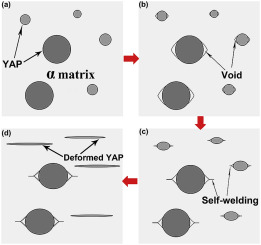当前位置:
X-MOL 学术
›
Acta Mater.
›
论文详情
Our official English website, www.x-mol.net, welcomes your
feedback! (Note: you will need to create a separate account there.)
Response of oxide nanoparticles in an oxide dispersion strengthened steel to dynamic plastic deformation
Acta Materialia ( IF 8.3 ) Pub Date : 2018-05-01 , DOI: 10.1016/j.actamat.2018.02.042 Zhenbo Zhang , Wolfgang Pantleon
Acta Materialia ( IF 8.3 ) Pub Date : 2018-05-01 , DOI: 10.1016/j.actamat.2018.02.042 Zhenbo Zhang , Wolfgang Pantleon

|
Abstract The behavior of oxide nanoparticles in an oxide dispersion strengthened (ODS) steel subjected to dynamic plastic deformation (DPD) was investigated by transmission electron microscopy (TEM) and high resolution TEM (HRTEM). Contrary to the motivation for dispersing oxides in a ferritic matrix that the hard particles would be non-deformable and constitute obstacles of plastic deformation, it is discovered that oxide nanoparticles with sizes smaller than 20 nm were appreciably deformed to an average equivalent strain of 1.2 in the sample after DPD to a strain of 2.1. The plastic distortion of the oxide nanoparticles by compression increases with the externally applied strain. HRTEM analysis demonstrates that deformation twinning is the dominant mechanism of plastic deformation for the oxide nanoparticles. In addition, experimental results show that the deformation of oxide nanoparticles does not only occur at high strain rates, but also at lower strain rates, and does not rely on the interfacial coherency between the oxide nanoparticle and the ferritic steel matrix. Due to the incompatible deformation between the oxide nanoparticles and matrix, nanoscale voids form at their interface during deformation at low strains, and evolve with increasing deformation in distinctively different manner around larger and smaller particles. The reasons for the size effect on the deformation of oxide nanoparticles and on the co-deformation between oxide nanoparticles and ferritic matrix in the ODS steel are discussed.
中文翻译:

氧化物弥散强化钢中氧化物纳米粒子对动态塑性变形的响应
摘要 通过透射电子显微镜(TEM)和高分辨透射电镜(HRTEM)研究了氧化物弥散强化(ODS)钢中氧化物纳米粒子在动态塑性变形(DPD)下的行为。与将氧化物分散在铁素体基体中的动机相反,硬颗粒将是不可变形的并构成塑性变形的障碍,发现尺寸小于 20 nm 的氧化物纳米颗粒明显变形到平均等效应变为 1.2 in DPD 后的样品应变为 2.1。氧化物纳米颗粒通过压缩产生的塑性变形随着外部施加的应变而增加。HRTEM 分析表明,变形孪晶是氧化物纳米粒子塑性变形的主要机制。此外,实验结果表明,氧化物纳米粒子的变形不仅发生在高应变率下,而且发生在较低应变率下,并且不依赖于氧化物纳米粒子与铁素体钢基体之间的界面相干性。由于氧化物纳米粒子和基体之间的不相容变形,在低应变下变形过程中,纳米级空隙在它们的界面处形成,并随着变形的增加而在更大和更小颗粒周围以截然不同的方式演变。讨论了尺寸对ODS钢中氧化物纳米颗粒变形和氧化物纳米颗粒与铁素体基体共变形的影响原因。并且不依赖于氧化物纳米颗粒和铁素体钢基体之间的界面相干性。由于氧化物纳米粒子和基体之间的不相容变形,在低应变下变形过程中,纳米级空隙在它们的界面处形成,并随着变形的增加而在更大和更小颗粒周围以截然不同的方式演变。讨论了尺寸对ODS钢中氧化物纳米颗粒变形和氧化物纳米颗粒与铁素体基体共变形的影响原因。并且不依赖于氧化物纳米颗粒和铁素体钢基体之间的界面相干性。由于氧化物纳米粒子和基体之间的不相容变形,在低应变下变形过程中,纳米级空隙在它们的界面处形成,并随着变形的增加而在更大和更小颗粒周围以截然不同的方式演变。讨论了尺寸对ODS钢中氧化物纳米颗粒变形和氧化物纳米颗粒与铁素体基体共变形的影响原因。并随着变形的增加以明显不同的方式围绕较大和较小的颗粒演变。讨论了尺寸对ODS钢中氧化物纳米颗粒变形和氧化物纳米颗粒与铁素体基体共变形的影响原因。并随着变形的增加以明显不同的方式围绕较大和较小的颗粒演变。讨论了尺寸对ODS钢中氧化物纳米颗粒变形和氧化物纳米颗粒与铁素体基体共变形的影响原因。
更新日期:2018-05-01
中文翻译:

氧化物弥散强化钢中氧化物纳米粒子对动态塑性变形的响应
摘要 通过透射电子显微镜(TEM)和高分辨透射电镜(HRTEM)研究了氧化物弥散强化(ODS)钢中氧化物纳米粒子在动态塑性变形(DPD)下的行为。与将氧化物分散在铁素体基体中的动机相反,硬颗粒将是不可变形的并构成塑性变形的障碍,发现尺寸小于 20 nm 的氧化物纳米颗粒明显变形到平均等效应变为 1.2 in DPD 后的样品应变为 2.1。氧化物纳米颗粒通过压缩产生的塑性变形随着外部施加的应变而增加。HRTEM 分析表明,变形孪晶是氧化物纳米粒子塑性变形的主要机制。此外,实验结果表明,氧化物纳米粒子的变形不仅发生在高应变率下,而且发生在较低应变率下,并且不依赖于氧化物纳米粒子与铁素体钢基体之间的界面相干性。由于氧化物纳米粒子和基体之间的不相容变形,在低应变下变形过程中,纳米级空隙在它们的界面处形成,并随着变形的增加而在更大和更小颗粒周围以截然不同的方式演变。讨论了尺寸对ODS钢中氧化物纳米颗粒变形和氧化物纳米颗粒与铁素体基体共变形的影响原因。并且不依赖于氧化物纳米颗粒和铁素体钢基体之间的界面相干性。由于氧化物纳米粒子和基体之间的不相容变形,在低应变下变形过程中,纳米级空隙在它们的界面处形成,并随着变形的增加而在更大和更小颗粒周围以截然不同的方式演变。讨论了尺寸对ODS钢中氧化物纳米颗粒变形和氧化物纳米颗粒与铁素体基体共变形的影响原因。并且不依赖于氧化物纳米颗粒和铁素体钢基体之间的界面相干性。由于氧化物纳米粒子和基体之间的不相容变形,在低应变下变形过程中,纳米级空隙在它们的界面处形成,并随着变形的增加而在更大和更小颗粒周围以截然不同的方式演变。讨论了尺寸对ODS钢中氧化物纳米颗粒变形和氧化物纳米颗粒与铁素体基体共变形的影响原因。并随着变形的增加以明显不同的方式围绕较大和较小的颗粒演变。讨论了尺寸对ODS钢中氧化物纳米颗粒变形和氧化物纳米颗粒与铁素体基体共变形的影响原因。并随着变形的增加以明显不同的方式围绕较大和较小的颗粒演变。讨论了尺寸对ODS钢中氧化物纳米颗粒变形和氧化物纳米颗粒与铁素体基体共变形的影响原因。









































 京公网安备 11010802027423号
京公网安备 11010802027423号